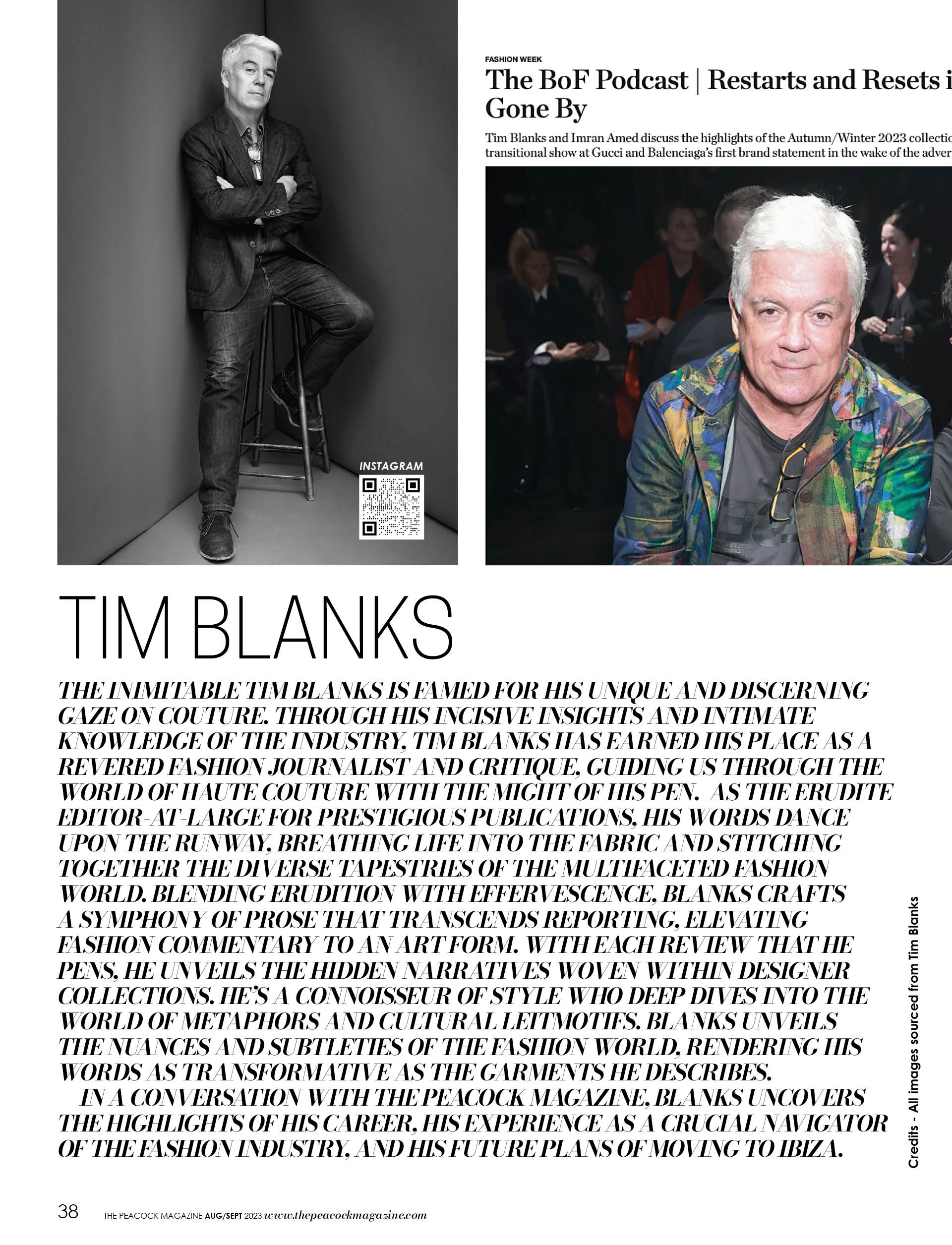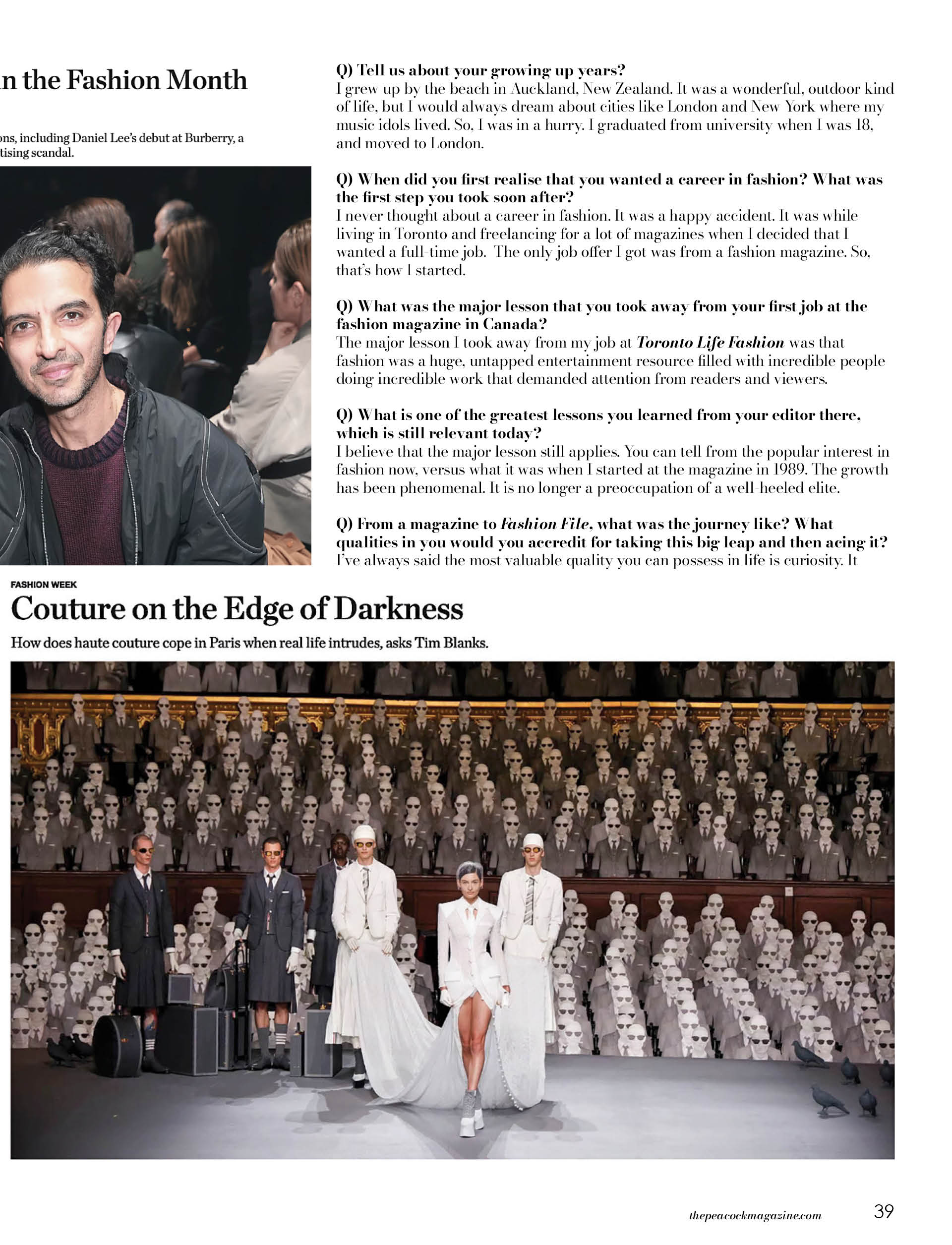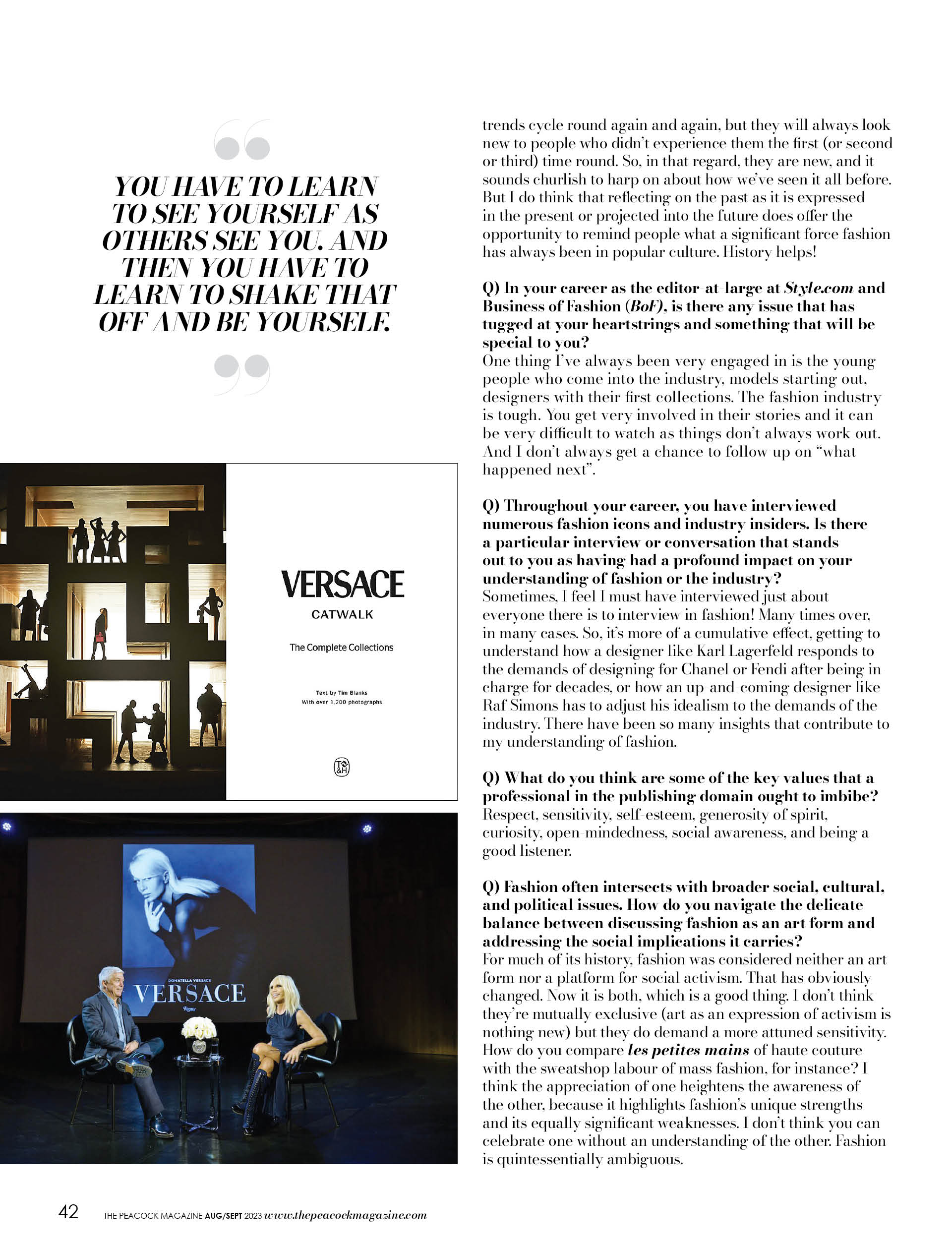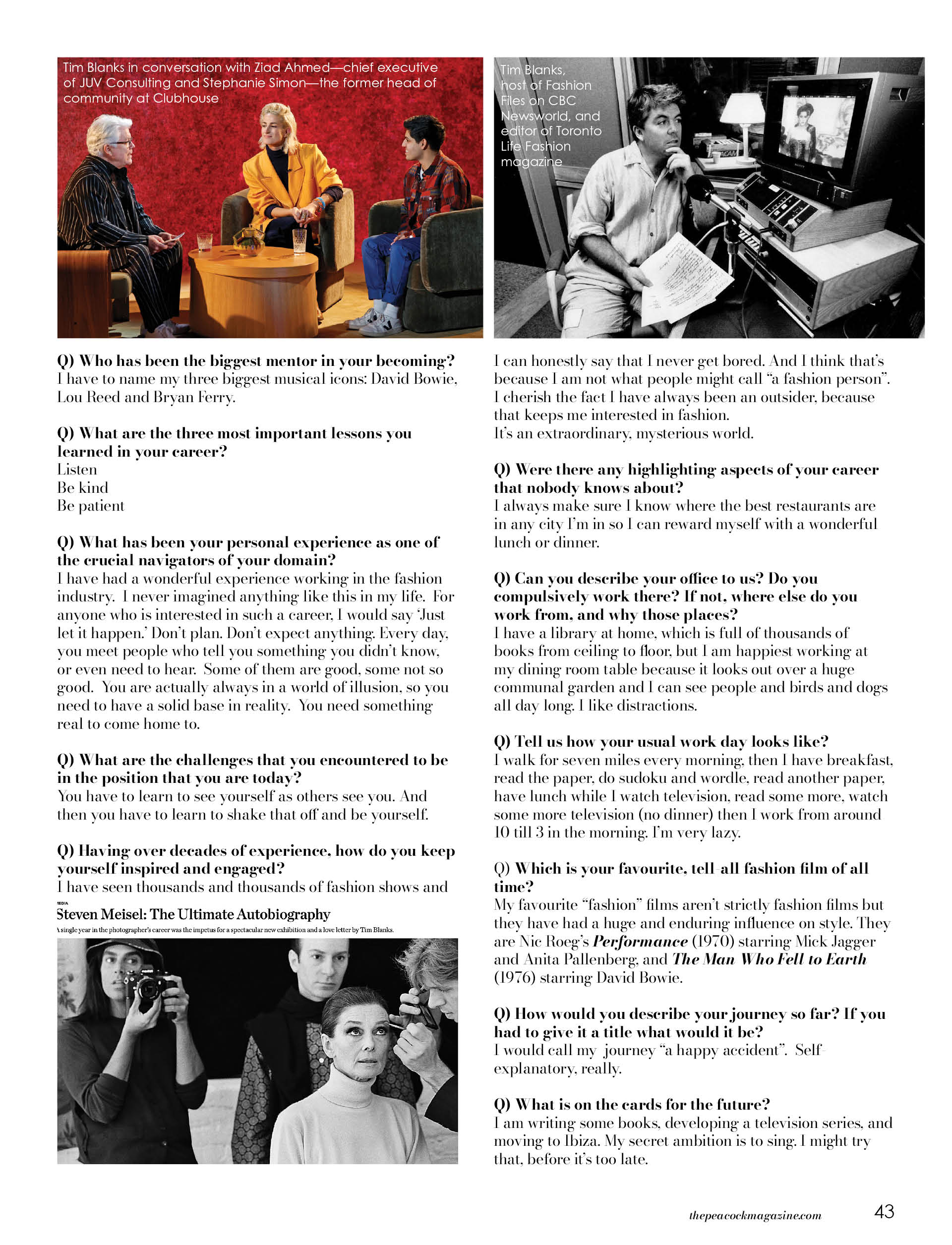
CREDITS – All images sourced from Team Tim Blanks
The inimitable Tim Blanks is famed for his unique and discerning gaze on couture. Through his incisive insights and intimate knowledge of the industry, Tim Blanks has earned his place as a revered fashion journalist and critique, guiding us through the world of haute couture with the might of his pen. As the erudite editor-at-large for prestigious publications, his words dance upon the runway, breathing life into the fabric and stitching together the diverse tapestries of the multifaceted fashion world. Blending knowledge with effervescence, Blanks crafts a symphony of prose that transcends reporting, elevating fashion commentary to an art form. With each review that he pens, he unveils the hidden narratives woven within designer collections. He’s a connoisseur of style who deep dives into the world of metaphors and cultural leitmotifs. Blanks unveils the nuances and subtleties of the fashion world, rendering his words as transformative as the garments he describes.
In a conversation with The Peacock Magazine, Blanks uncovers the highlights of his career, his experience as a crucial navigator of the fashion industry, and his future plans of moving to Ibiza.

Q) Tell us about your growing up years?
I grew up by the beach in Auckland, New Zealand. It was a wonderful, outdoor kind of life, but I would always dream about cities like London and New York where my music idols lived. So, I was in a hurry. I graduated from university when I was 18, and moved to London.
Q) When did you first realise that you wanted a career in fashion? What was the first step you took soon after?
I never thought about a career in fashion. It was a happy accident. It was while living in Toronto and freelancing for a lot of magazines when I decided that I wanted a full-time job. The only job offer I got was from a fashion magazine. So, that’s how I started.
Q) What was the major lesson that you took away from your first job at the fashion magazine in Canada?
The major lesson I took away from my job at Toronto Life Fashion was that fashion was a huge, untapped entertainment resource filled with incredible people doing incredible work that demanded attention from readers and viewers.
Q) What is one of the greatest lessons you learned from your editor there, which is still relevant today?
I believe that the major lesson still applies. You can tell from the popular interest in fashion now, versus what it was when I started at the magazine in 1989. The growth has been phenomenal. It is no longer a preoccupation of a well-heeled elite.
Q) From a magazine to Fashion File, what was the journey like? What qualities in you would you accredit for taking this big leap and then acing it?
I’ve always said the most valuable quality you can possess in life is curiosity. It motivated me as a magazine editor and that continued over into making a television show. Fashion is a very wide platform, there are a lot of stories to tell, from designers and models to the hair and makeup people, the icons, the audience. All I’ve ever had to be was curious, ask questions, then stand back and let the magic happen.

Q) How did Fashion File come about? What vision did you have for it as a host when you started?
The Canadian Broadcasting Corporation was starting CBC Newsworld, a 24-hour news channel, kind of their version of CNN, and I knew they would need as much content as possible, so I pitched a show to them that would cover the entire global world of fashion. I’d never actually seen The Clothes Show in the UK, but I thought it sounded like a great idea. Later, when I actually got to see The Clothes Show, it was NOTHING like Fashion File. We were much more about the personalities, the creativity, the showmanship.
Q) Being at the helm of Style.com, how did you cope with the pressure of delivering quality content every single time?
When I started at Style.com, I would initially cover the men’s collections—up to 10 shows a day. It was absolute madness, but it was so exciting to feel that you were a part of something new. There were times when I’d write all night and then the car would pick me up for a show in the morning. But I don’t remember ever being exhausted. And quite quickly, I started getting responses to my reviews, which was very gratifying.
Q) Fashion criticism plays a vital role in shaping public opinion and discourse around designers and their work. How do you approach the task of critiquing fashion, and what criteria do you use to evaluate the success or failure of a collection?
I’ve always shied away from the idea that what I do is criticise. I have always taken the view that I write about the show, because that is the experience a designer wants me to have of their collection. So, there are a lot of different elements involved. I like the film critic AO Scott’s idea that a critic is more of a companion. So, I am the reader’s eyes and ears at a fashion show: not just how it looks, but how it sounds, even what it smells like. That said, there are certain things I look for. I love it when sound and vision work together to tell a story (John Galliano and Alexander McQueen were always brilliant at this). I love it when a designer takes risks, and has the talent to make those risks pay off. I love it when design is intelligent, idiosyncratic and true. It’s easy to spot a fake.

Q) The rise of social media has transformed the way fashion is consumed and discussed. How do you think this digital era has affected the role of fashion journalists and critics, and what challenges and opportunities does it present?
There is so much more of everything in the world now—good and bad. And social media offers instant, easy access to worlds that were once closed to all but a select few. It’s amazing to think that when I started, there were a couple of hundred people at a show and the rest of the world had to wait till they’d written their words or developed their film or printed their newspapers and magazines before anyone knew what had happened on the runway. The biggest impact of the digital era is that it has asserted the dominance of images. Words come a distant second. But they are still meaningful as a documentary record of the moment. Opportunities exist for good writers, because a good writer is always going to be a joy to read, no matter what they’re writing about, fashion, sports or politics or whatever. And it’s the same with opinions.
Q) Fashion is known for its cyclical nature, with trends often being recycled or reinvented. How do you approach the challenge of providing fresh and insightful commentary on collections that may draw inspiration from the past?
It’s true that in my 35 years in fashion I have seen certain trends cycle round again and again, but they will always look new to people who didn’t experience them the first (or second or third) time round. So, in that regard, they are new, and it sounds churlish to harp on about how we’ve seen it all before. But I do think that reflecting on the past as it is expressed in the present or projected into the future does offer the opportunity to remind people what a significant force fashion has always been in popular culture. History helps!

Q) In your career as the editor-at-large at Style.com and Business of Fashion (BoF), is there any issue that has tugged at your heartstrings and something that will be special to you?
One thing I’ve always been very engaged in is the young people who come into the industry, models starting out, designers with their first collections. The fashion industry is tough. You get very involved in their stories and it can be very difficult to watch as things don’t always work out. And I don’t always get a chance to follow up on “what happened next”.
Q) Throughout your career, you have interviewed numerous fashion icons and industry insiders. Is there a particular interview or conversation that stands out to you as having had a profound impact on your understanding of fashion or the industry?
Sometimes, I feel I must have interviewed just about everyone there is to interview in fashion! Many times over, in many cases. So, it’s more of a cumulative effect, getting to understand how a designer like Karl Lagerfeld responds to the demands of designing for Chanel or Fendi after being in charge for decades, or how an up-and-coming designer like Raf Simons has to adjust his idealism to the demands of the industry. There have been so many insights that contribute to my understanding of fashion.
Q) What do you think are some of the key values that a professional in the publishing domain ought to imbibe?
Respect, sensitivity, self-esteem, generosity of spirit, curiosity, open-mindedness, social awareness, and being a good listener.
Q) Fashion often intersects with broader social, cultural, and political issues. How do you navigate the delicate balance between discussing fashion as an art form and addressing the social implications it carries?
For much of its history, fashion was considered neither an art form nor a platform for social activism. That has obviously changed. Now it is both, which is a good thing. I don’t think they’re mutually exclusive (art as an expression of activism is nothing new) but they do demand a more attuned sensitivity. How do you compare les petites mains of haute couture with the sweatshop labour of mass fashion, for instance? I think the appreciation of one heightens the awareness of the other, because it highlights fashion’s unique strengths and its equally significant weaknesses. I don’t think you can celebrate one without an understanding of the other. Fashion is quintessentially ambiguous.

Q) Who has been the biggest mentor in your becoming?
I have to name my three biggest musical icons: David Bowie, Lou Reed and Bryan Ferry.
Q) What are the three most important lessons you learned in your career?
- Listen
- Be kind
- Be patient
Q) What has been your personal experience as one of the crucial navigators of your domain?
I have had a wonderful experience working in the fashion industry. I never imagined anything like this in my life. For anyone who is interested in such a career, I would say ‘Just let it happen.’ Don’t plan. Don’t expect anything. Every day, you meet people who tell you something you didn’t know, or even need to hear. Some of them are good, some not so good. You are actually always in a world of illusion, so you need to have a solid base in reality. You need something real to come home to.
Q) What are the challenges that you encountered to be in the position that you are today?
You have to learn to see yourself as others see you. And then you have to learn to shake that off and be yourself.
Q) Having over decades of experience, how do you keep yourself inspired and engaged?
I have seen thousands and thousands of fashion shows and I can honestly say that I never get bored. And I think that’s because I am not what people might call “a fashion person”. I cherish the fact I have always been an outsider, because that keeps me interested in fashion.
It’s an extraordinary, mysterious world.
Q) Were there any highlighting aspects of your career that nobody knows about?
I always make sure I know where the best restaurants are in any city I’m in so I can reward myself with a wonderful lunch or dinner.
Q) Can you describe your office to us? Do you compulsively work there? If not, where else do you work from, and why those places?
I have a library at home, which is full of thousands of books from ceiling to floor, but I am happiest working at my dining room table because it looks out over a huge communal garden and I can see people and birds and dogs all day long. I like distractions.
Q) Tell us how your usual work day looks like?
I walk for seven miles every morning, then I have breakfast, read the paper, do sudoku and wordle, read another paper, have lunch while I watch television, read some more, watch some more television (no dinner) then I work from around 10 till 3 in the morning. I’m very lazy.
Q) Which is your favourite, tell-all fashion film of all time?
My favourite “fashion” films aren’t strictly fashion films but they have had a huge and enduring influence on style. They are Nic Roeg’s Performance (1970) starring Mick Jagger and Anita Pallenberg, and The Man Who Fell to Earth (1976) starring David Bowie.
Q) How would you describe your journey so far? If you had to give it a title what would it be?
I would call my journey “a happy accident”. Self-explanatory, really.
Q) What is on the cards for the future?
I am writing some books, developing a television series, and moving to Ibiza. My secret ambition is to sing. I might try that, before it’s too late.
